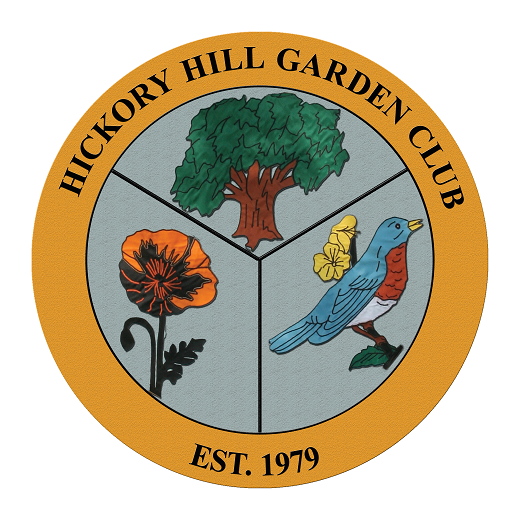Fall starts September 1st
September is time to:
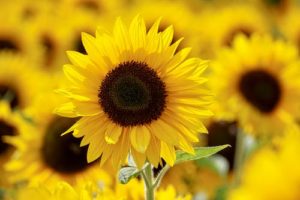
- Plant chrysanthemums now, and sow seeds for all annuals such as pansies, calendula, dianthus, larkspur, stock, and Phlox drummondi.
- Take propagation cuttings from nonhardy perennial woody plants, such as hibiscus, butterfly bush, and mandevilla.
- Do not fertilize lawns with nitrogen fertilizer. It’s too late!
- September is an important month for cleanup: leaves, mulch, hummingbird feeders – whatever could harbor disease and insects.
- Treat adult mole crickets with Bayer Complete Insect Killer Liquid or Granules (contains Merit) or Ortho Bug-B-Gon Max Insect Killer for Lawns (contains Bifenthrin).
- Apply pre-emergent herbicides to your lawn when nighttime temperatures fall to 55 degrees to 60 degreea for 4-5 consecutive nights to help prevent winter weeds such as poa annua bittercress, but watch any temp cautions on labels.
Landscaping Maintenance
Spray camellias with horticultural oil to prevent fall infestations of scale if it’s not too hot; otherwise, hold up for a few more weeks. Camellias can be gibbed now for earlier and larger blooms.
If you have had problems with twig borers, September 1st is the date to spray, use a product labeled for borers.
October is time to:
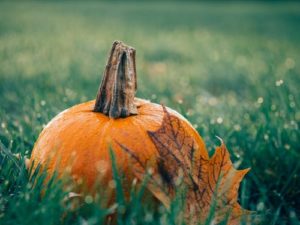
- Sow seeds of strawberry, spinach, ornamental cabbage, kale, fennel, green leaf, red leaf, Boston and romaine lettuces, radish, parsley and cilantro. Plant strawberry, onion, ornamental cabbage and kale transplants now.
- Sow larkspur, sweet pea, poppy, and wildflowers seeds where they are to grow.
- Plant perennial, biennial, and cool-weather annual beds now through next month.
- Put perennial candytuft, dianthus, Shasta daisy, snapdragons, pansies, and stock in the ground.
- Sow collard seeds on Halloween for eating on New Year’s Day.
- Root-prune trees and shrubs for transplanting 30 days later.
- Prune long and irregular shoots on evergreen shrubs. This is just to shape! Do not undertake major pruning until early next spring.
- In general, it is best to divide spring and summer blooming perennials in the fall, and fall bloomers in spring. By dividing the plant when it is not flowering, all the plant’s energy can go to root and leaf growth. Fall division should take place mid-to late October on the coast. Now is the time to divide perennials such as:
- Beebalm (Monarda)
- Bellflower (Campanula)
- Black-eyed Susan (Rudbeckia fulgida)
- Daylilies (Hemerocallis)
- Lily of the Nile (Agapanthus)
- Purple-cone-flower (Echinacea)
- Red-hot-pepper (Kniphofia)
- Tickseed (Coreopsis)
- Shelter poinsettias from light, from sundown to sunup, after October 15 – they need to be on nature’s schedule (which includes complete darkness) for bloom.
- Prepare roses for winter: lightly prune very long canes, spray for insects and diseases, and remove and replace mulch.
- Refrigerate tulip and hyacinth bulbs for planting in Dec. and Jan.
- Paper Whites Forcing Calendar – Blooms begin 4 – 6 weeks after planting. Planting Date: Oct. 1, Blooms Begin: Oct. 22 – Nov. 5. Planting Date: Oct. 15, Blooms Begin: Nov. 5 – Nov. 19.
Landscape Maintenance
Shape up your plants and prune out diseased or infected limbs, if needed, but do not undertake major pruning until early next spring.
Plant cool season annuals this month.
Put away fertilizers. Nitrogen encourages foliar growth which may be seriously damaged by a frost.
November is time to:
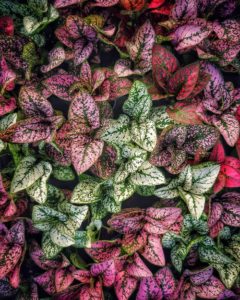
- Transplant those trees and shrubs you root-pruned last month.
- Refill bird feeders, suet cages, and birdbaths to accommodate the southern migration.
- By now you should have moved all of your houseplants back indoors for the winter. Carefully inspect your plants for insects they might have brought in with them.
- Rake leaves for compost pile. This will help eliminate overwintering insects,
- Plant trees and shrubs. If they are planted in the fall, new roots have time to grow and become established before spring.
- Perennials, iris, and daylilies may still be divided and transplanted.
- Divide and replant dahlias after the first killing frost.
- Pinch back snapdragons for bushier growth.
- After chrysanthemums have finished blooming, cut back to five inches above the ground.
- A gentle spray to remove frost off tender plants prevents leaf scorch damage if done before the sun shines on them.
- If you must have a green lawn all winter, sow perennial ryegrass seed. It’s more disease-resistant than the annual variety. Do not sow too thickly and keep it mowed.
- Rye will ruin centipede if sown every year.
- Paper Whites Forcing Calendar – Blooms begin 4 – 6 weeks after planting. Planting Date: Nov. 1, Blooms Begin: Nov. 22 – Dec. 6. Planting Date: Nov. 15, Blooms Begin: Dec. 6 – Dec. 20.
Landscape Maintenance
Rake leaves for compost pile. This will help eliminate over-wintering insects.
Plant trees and shrubs, if they are planted in the fall, new roots have time to grow and become established before spring.
Winter starts December 1st
December is time to:

- Establish new flower beds and vegetable garden areas.
- Start working your flower beds and garden plots for next season. Turn the soil to expose insects and weed seeds to the elements.
- Fertilize winter annuals, such as pansies, and check for aphids. If aphids are present, blast them off with a spray from garden hose, Malathion or use an insecticidal soap, be sure to read the label for instructions.
- Water and fertilize your houseplants less frequently over the next couple of months. They are going into a semi-dormant resting period and should be allowed this natural period in their life cycle.
- Plant spring-flower bulbs such as daffodils, crocus, Grape Hyacinths (Muscari species).
- Trees and shrubs may still be planted. Keep soil mulched and well-watered to protect from freezing temperatures.
- Place potted poinsettias in bright light but away from draft. Water twice a week. Remove decorative wrapping from bottom of pot to allow proper drainage.
- The only thing roses need now is water and their monthly spray for black spot. Resist pruning, deadheading, or feeding. Begin transplanting at the end of this month.
- As cold weather sets in, reduce the amount of water, but do not allow roses to completely dry out. Plants need water during dry spells, even during winter months.
- Collect and submit soil samples for your lawn, trees, flowerbeds, and vegetable garden. Soil samples can be taken at any time of the year, but it is best to sample the soil a couple months before planting a garden, establishing perennials or before the optimum time for fertilizing lawns.
- Paper Whites Forcing Calendar – Blooms begin 4 – 6 weeks after planting. Planting Date: Dec. 1, Blooms Begin: Dec. 22 – Jan. 5. Planting Date: Dec. 15, Blooms Begin: Jan. 5 – Jan. 19.
Landscape Maintenance
Take a soil sample to the Extension office for analysis.
Plant and mulch roses, trees, and shrubs.
Keep plants watered to protect from freezing temperatures.
January is time to:
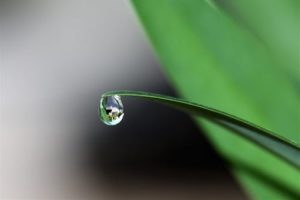
- Plant living Christmas trees outdoors as soon as possible after brief acclimation period on a protected porch or garage.
- Clean up fallen camellia blooms to prevent or control petal blight.
- Plant or transplant roses, trees, and shrubs.
- Plant bare root roses as soon as you receive them. Soak the plants in water for 12 to 24 hours before planting to rehydrate the roots and plant so the graft bud union is 2 inches above the ground level. After planting, mound soil over bud union and water well. This will protect canes from drying winds until new growth begins.
- Plant asparagus crowns, cabbage transplants and the seeds of beets, carrots, lettuce, mustard, garden peas, radishes, spinach and turnips.
- Plant onion seeds in flats to establish sets for spring transplanting in February.
- Sweet peas and strawflower seeds can be sown directly into the soil now. Start other seeds in flats for spring transplants. It takes about 8 weeks for most seeds to reach transplant size.
- Spray trees and shrubs with dormant oil to kill overwintering insects and eggs. Watch those minimum temperatures on the label, though!
- Apply s light feeding of 0-20-20 to roses in order to promote root growth.
- Take down climbing roses and remove old canes. Tie up and train good canes to grown horizontally. Do not prune once-bloomers until after their first bloom.
- Develop a preventive spray program for your roses based on the type of roses you have.
- Get your pruning equipment ready for use. Feb. 17 – Mar. 17, is the optimum time to prune most of your landscape and woody fruit plants, but a lot can be started in January. The rule of thumb is, if it blooms before June 1st, prune at last bloom or if it blooms after June 1st, prune before last frost just prior to spring growth. Prune the following within six weeks of the last boom-fade: Confederate roses, camellias and climbing roses that are not repeat bloomers.
- Paper Whites Forcing Calendar – Blooms begin 4 – 6 weeks after planting. Planting Date: Jan. 1, Blooms Begin: Jan. 22 – Feb. 5. Planting Date: Jan. 15, Blooms Begin: Feb. 5 – Feb. 19.
Landscape Maintenance
Apply a light feeding of 0-20-20 to roses in order to promote root growth.
Get your pruning equipment ready for use in mid-February through March. Take down climbing roses and remove old canes. Tie up and train good canes to grown horizontally. Don not prune once-bloomers until after their first bloom.
Divide miniature roses with woody centers by splitting the plants into several sections and replanting. Discard woody growth.
Clean up fallen camellia blooms to prevent and control petal blight.
Plant or transplant roses, trees, and shrubs.
Plant base root roses as soon as possible after you receive them. Soak the plants in water doe 1 to 24 hours before planting to rehydrate the roots and plant so the graft bud union is 2 inches above ground level. After planting, mound up well over the bud union with soil and water well. This will protect canes from drying winds until new growth begins.
Spray trees and shrubs with dormant oil to kill over-wintering insects and eggs. Watch those minimum temperatures on the label, though! If using sulfur sprays to kill over-wintering fungal pathogens on ornamentals, be use to allow 10 days between sulfur and oil sprays.
February is time to:

- Pre-emergent herbicides can be applied to established lawns in late February or early March, depending on what sort of weather we have. Apply after daytime temperatures have reached 65 – 70 degrees, for 4 -5 days in a row. A good rule of thumb is to apply them when forsythia and crabapple bloom.
- Fertilize fruit and nut trees, ornamental trees, azaleas, and camellias, if needed and based on soil test recommendations.
- Divide and transplant perennial flowers such as asters, coreopsis, chrysanthemums, daylilies, gaillardias, and Shasta daisies.
- Plant onion sets, Irish potato tubers, seeds of broccoli, collards, lettuce and radish. Seed flats indoors of eggplant, peppers, tomatoes, parsley, perennial, and annual herbs.
- Because flowing ornamentals form their flower buds at different times of year, pruning times must be adjusted accordingly. Plants that typically flower during the summer form flower buds on new growth and can be pruned during the winter with no effect on their flowering. Typically, mid-February through mid to late March is the optimum time to prune most summer-flowering trees and shrubs in our area (just after last predicted frost). Summer-flowering trees and shrubs to prune during this time include:
- Beautyberry (Callicarpa species)
- Crapemyrtle (Lagerstroemia species)
- Butterfly-bush (Buddleia davidii)
- Goldenraintree (Koelreuteria species)
- Fragrant Tea Olive (Osmanthus fragrans)
- Camellia (Camellia species)
- Glossy Abelia (Abelia x grandiflora)
- Chastetree (Vitex agnus-castus)
- Gardenia (Gardenia jasminoides)
- Japanese Spirea (Spiraea japonica)
- Sourwood (Oxydendrum arboreum)
- Anthony Waterer Spirea (Spiraea x bumalda ‘Anthony Waterer’)
- Sweetshrub (Calycanthus mutabilis)
- Confederate Rose (Hibiscus mutabilis)
- Ornamental grasses (including sweet grass) should be cut within 3″ of ground level (use hedge shears, a weed eater, or lawn mower) before new growth begins. This should be done in late February on the coast.
- Paper Whites Forcing Calendar – Blooms begin 4 – 6 weeks after planting. Planting Date: Feb. 1, Blooms Begin: Feb 22 – Mar. 7. Planting Date: Feb. 15, Blooms Begin: Mar. 7 – Mar. 22.
Landscape Maintenance
Turn your compost pile. You will be using it soon, and you want to make sure those little microbes get plenty of oxygen so the compost will be ready when you are.
February 17 through March 17 is the optimum time to prune most summer-flowering trees and shrubs. Nonetheless, do cut the occasional branch of camellias and azaleas to enjoy indoors. However, we suggest holding off dormant-season pruning chores until after the danger of severe cold, i.e., 25 degrees or below, has passed. Newly exposed plant cells are tender, and can be killed by freese. The damage can extend down the limb from the pruning cut. You would like to have a guarantee of about two weeks of non-freesing tempartues after pruning; so early March is a safer time. Although more sap will be running, as buds start to swell, the plant is not going yo bleed to death.
Spray roses with formant oil, fungicide, and insecticide to prevent diseases and kill insect eggs. Some also use a lime sulfur spray during this cool season.
Divide and transplant perennial flowers. Cut back pampas grass, liriope, and other ornamental grasses.
Wash out birdhouses and get them ready to receive this year’s migration.
When pruning hydrangeas, remember that they bloom on second-year wood, and should not be pruned after August 1. As a general rule, plants that bloom before June 1st should be pruned after they flower while those that flower after June 1st are considered summer-flowering and can be pruned just prior to spring growth.
Spray horticultural oil or sulfur to kill over-wintering insects and disease. Use horticultural oil this month to prevent problems later.
Apply a fungicide to prevent petal blight on azaleas. Begin spraying when flower buds show color, and spray every 7 – 10 days, as long as new buds are coming.
Fertilize azaleas and camellias. Use fertilizer especially formulated for these acid-loving plants. Scatter the fertilizer on top of the mulch and water very well.
Fertilize ornamentals trees, with the exception of Bradford pear trees. General, 1 pound of fertilizer per inch of trunk diameter (measured at chest height) works well. An 18-5-11 formulation is best, but you may also use 16-4-8 or 12-6-6 is acceptable.
Spring begins March 1st
March is time to:
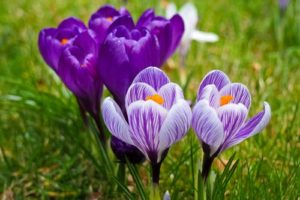
- DO NOT fertilize grass until 2 weeks after it has become fully green.
- If necessary, treat now for control of mole crickets. Adults are most active at this time.
- Warm days and cool night will encourage black spot and insects on roses, so a regular spray schedule should begin now. Spray at dusk to avoid killing bees.
- Do nor remove leaves from spent bulbs until they turn brown. This allows the energy from the leaves to build up the bulb for next year’s bloom. Permanent bulb plantings should be fertilized by mixing bone meal in the rooting area at planting time with an application of quick-release fertilizer at the rate of 1 to 2 pounds of 10-10-10 per 100 square feet in the fall. Repeat the application of 10-10-10 as soon as you see shoots emerging in the spring.
- Fertilize shrubs as soon as they begin to show new growth. A formulation of 16-4-8 with at least half its nitrogen in slow release form is good for most shrubs. Use 1/2 cup per shrub for plants with a foliage spread of 3 feet; for smaller plants, a little less; for larger ones, a little more. Or use 2 pounds of fertilizer per 100 square feet of root area. Also fertilize ornamental trees, azaleas, and camellias if not done in February. A slower-release fertilizer will save time and prevent burning on early-blooming bedding plants.
- Be sure to “harden off” annual and perennial plants before planting them by bringing them indoors (or into the garage) during the night for about 4 nights and then take them outside during the day – this will acclimate against cooler night temperatures.
- This is the time to start summer-flowering annuals from seed indoors or in a cold frame. Many can be planted directly into soil; check seed pack for instructions.
- Start warm season vegetables from seed including snap, pole, half-runner, bush lima and pole lima beans, cantaloupes, collards, cucumbers, cowpea/black-eyed peas, sweet corn, summer and winter squash, turnips, watermelons, and most herbs.
- Move eggplant, onion, pepper, and tomato seedlings into the garden after last frost in your area.
- Spray dormant oil on camellias, hollies, gardenia, and citrus to control scale and whitefly.
- Fortunately, Fig trees require little to no fertilization. Heavily fertilized fig trees are more prone to cold injury. If the fig tree is showing very little vegetative growth, apply about a half-pound of 10-10-10 fertilizer when growth begins in the spring. (1/3 lb. 10-10-10 per foot of height).
- Replace old mulch to get rid of disease pathogens that may have over-wintered.
- Paper Whites Forcing Calendar – Blooms begin 4 – 6 weeks after planting. Planting Date: March 1, Blooms Begin: Mar. 22 – Apr. 5.
Landscape Maintenance
Prune roses the first of March. Climbers, shrubs and old garden roses that bloom only once in the spring should be pruned after they bloom.
Begin routine spraying of roses. Do not spray when honey bees are present. Warm days and cool night will encourage black spots and insects on roses, so a regular spray schedule should begin now.
Replace old mulch with fresh material to get rid of diseases pathogens that may have over-wintered. Wait until azaleas have finished blooming to replace their mulch. Getting rid of their fallen petals will help control future petal blight.
Fertilize shrubs as soon as they begin to show new growth. A formulation of 16-4-8 with at least half its nitrogen in slow-release form is good for most shrubs. Use 1/2 cup per shrub for plants with foliage spread of 3 feet; for smaller plants, a little less; for larger ones, a little more. Or use 2 pounds of fertilizer per 100 square feet of root area.
Spray dormant oils on camellias, hollies, gardenia, and citrus to control scale and whitefly.
If you have had twig borers, spray dates are March 1, June 1, and September 1, use an insecticide labeled for twig borers.
April is time to:
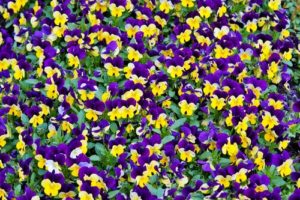
- Lawns may be sprigged or sodded now. You can seed if soil temperatures are warm enough (65 – 70 degrees).
- Fertilize fruit and nut trees, and vines. Each plant has its own quirks, so get recommendations from a soil test or Clemson publications.
- Attack Florida betony, also known as “wild artichoke”, with Atrazine. However, it is only recommended if you have no roots of desirable shrubs or trees in the area. Herbicides containing Atrazine are labeled for use on St. Augustine grass and centipede grass lawns will help control Florida betony but won’t necessarily eliminate it. It is recommended to apply Atrazine in fall and to re-apply in midwinter to early spring before grass green-up.
- Watch for mole cricket activity, particularly if you’ve had trouble in the past.
- Plant cannas, caladiums, and gladiolus bulbs. Stagger your gladiolus plantings every two weeks for an extended blooming season; in sandy soils, plant them 6″-7″ deep; in cay soil, 4″ is sufficient. Fertilize cannas by applying 3 to 4 pounds of 10-10-10 per 100 square feet every 4 to 6 weeks throughout the growing season and water thoroughly. Caladiums require a warm, moist soil to grow. Planting in cool soil results in slow growth or tuber rot. Water frequently and thoroughly, keeping the soil evenly moist to touch but not saturated. Do not let caladiums sit in water if planted in a container. Fertilize caladiums regularly with a soluble fertilizer to promote strong foliage growth.
- Begin moving tender plants that have spent the winter in your house out-of-doors. Gradually harden them off by exposing them to longer periods outside. Repot them to larger pots if necessary.
- Dig up and divide spring flowering bulbs after the flowers have faded and the foliage has browned. Bulbs are overcrowded when they begin to look slightly stunted, and the flowers are smaller or fewer in number.
Landscape Maintenance
Watch all new growth for insects!
Plant herbs, annuals and perennials and begin monthly fertilization program.
Begin moving tender plants that have spent the winter in your house out-of-doors. Gradually harden tender them off by exposing them to longer periods outside. Repot them to larger pots if necessary.
May is time to:
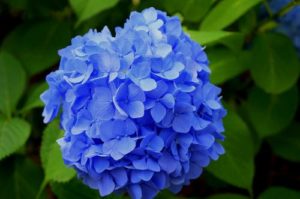
- Continue to plant warm season “bulbs”, such as gladiolas, caladiums, cannas, and dahlias and tender annuals such as begonias, petunias, portulacas, verbenas, zinnias, cosmos, and pentas.
- Deadhead to encourage more blooms.
- Check for lawn diseases.
- Remember the rule of thumb that to prune that bloom before June 1st right after flowering. Now is the time to prune these spring bloomers:
- Alternate-leaf Butterfly-bush (Buddleia alternifolia), Azalea (Rhododendron species), Beautybush (Kolkwitzia amabilis), Bigleaf Hydrangea (Hydrangea macrophylla), Bradford Pear (Pyrus calleryana ‘Bradford’), Bridalwreath Spirea (Spiraea prunifolia), Clematis (Clematis species), Climbing roses, Crabapple (Malus species), Deutzia (Deutzia species), Dogwood (Cornus species), Doublefile Viburunum (Viburnum plicatum var. tomentosum), Flowering Almond (Prunus species), Flowering Cherry (Prunus serrulata), Flowering Quince (Chaenome;es species), Forsythia (Forsythia species), Indian Hawthorn (Raphiolepsis umbellata), Japanese Kerris (Kerria japonica), Japanese Pieris (Pieris japonica), Mockorange (Philadelphus species), Oakleaf Hydrangea (Hydrangea quercifolia), Pyracantha (Pyracantha species), Redbud (Cercis species), Saucer Magnolia (Magnolia x soulangiana), Star Magnolia (Magnolia stellata), Thunberg Spirea (Spiraea thunbergii), Weigela (Weigela florida), White Fringetree (Chionanthus virginicus), Winter Daphne (Daphne odora), Wisteria (Wisteria species), Witchhazel (Hamamelis).
- Although it is not necessary to replace mulches on most trees, shrubs, and flowerbeds, for some disease susceptible plants such as roses, azaleas and camellias, it might be wise to collect and remove mulches that can harbor diseases and insects.
- Many perennials such as garden Chrysanthemums and spider lilies can be divided and replanted now.
- This is also the time to dethatch if thatch is a problem. Be sure you are following fertility recommendations for your grass type. Over-fertilization can lead to thatch as well as disease and insect problems.
- Inspect for insects and diseases regularly as they will begin to flourish on your tender plants now.
Landscape Maintenance
Prune spring-flowering shrubs after they’ve finished blooming. These include azaleas, camellias, flowering quince, forsythia, mock orange, spirea and weigelia. Also prune climbing roses that bloom once a year.
Dead head flowering plants to encourage more blooms.
Inspect plants for scale, aphids, spider mites and other insects.
Summer begins June 1st
June is time to:
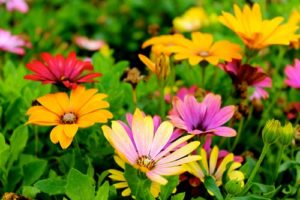
- Fertilize Amaryllis in the garden. Fertilization determines the size and quality of the flowers and foliage. For garden plantings, use fertilizers that contain low nitrogen, such as 5-10-10 or 6-12-12 analysis. Apply 1 to 1 1/2 pounds per 100 square feet or 100 feet of row to be established. A bulb booster type fertilizer can also be used. Make the first fertilizer application as new growth begins, then repeat the application when flower stalk is 6 to 8 inches tall. Apply a third application immediately after flowering when the old flower heads and flower stems have been removed.
- Monitor your Azaleas and camellias for leaf galls which are often harmless and are caused by gall flies and wasps and sometimes by fungi or other causal agents. Galls can be easily removed by hand. If the infestation is fungal and is severe, initiate mancozeb sprays at bud break and continue at 7 to 14-day intervals through June. For camellias (sasanquas are more of a problem than japonicas), begin mancozeb sprays at bud break and continue through June 1; handpick galls at 1 to 2-day intervals. Foliage sprays are limited in effectiveness.
- Plan now for fall vegetable gardens by sowing flats of lettuce, broccoli, cauliflower, collards, and spinach for August planting.
- Plant dahlia tubers and gladiolus bulbs for fall flowering.
- Reduce the amount of fertilizer applied to roses during June, July, and August by half but continue to feed after each bloom cycle. Roses require lots of fertilizer, but excessive fertilizer can burn plant. Always make sure that the soil is moist before applying fertilizer and water after application.
Landscape Maintenance
Monitor azaleas and camellias for leaf galls, often caused by gall flies and wasps, are primarily a cosmetic problem for many plants and can be easily removed by hand. Azalea and camellia galls may be caused by a fungus. For azaleas, pick and destroy galls as soon as they appear; initiate mancozeb sprays at resumption of growth and continue at 7-14-day intervals through June. For camellias (sasanquas are more of a problem than japonicas) begin mancozeb sprays at bud break and continue through June 1; hand pick galls at 1 to 2-day intervals, as the foliage spray is limited in effectiveness.
Ensure all your plants are receiving at least 1 inch of water every week. Azaleas and dogwoods are very shallow- rooted and require watering every 4-5 days. Never water anything after noon! The best time is morning, after dew has dried. Most disease gets started when plants go to bed wet.
July is time to:
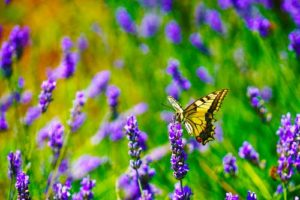
- Fertilize blueberries. Blueberries are easily damaged by excess fertilizer. Apply the recommended amount and allow 4 inches of rain or an equivalent amount of irrigation between applications. Do not fertilize immediately after planting. Wait until the first leaves reached full size, then apply 1 tablespoon of a special azalea fertilizer (10-8-8 or 11-7-7) within a circle 12 inches away from each plant. Fruit bearing plants should be fertilized with 10-10-10.
- Fertilize warm-season lawns with the second application, except centipede, for the year. If you have disease in your lawn, do not fertilize at all. Disease flourishes on tender new growth. If lawn appears healthy, annual fertilization may not be necessary.
- Prune gardenias after last bloom has faded (if not already done).
- Continue to pinch back the growing tips of chrysanthemums until mid-July. Button/cushion and pacificum chrysanthemums can be pruned back to a couple of inches from the ground and still have time to regrow and flower for fall color.
- Rejuvenate impatiens with a hard pruning. Remember to be brave and cut them back within a few inches of the ground to give them new life through late summer and fall.
- Cut back herbs such as basil, mint, and oregano to keep them more compact.
- Sow flats of pansies, sweet peas, calendulas, alyssum, poppies, and candytuft seeds for September transplanting.
- Zinnias may still be planted, or seed sown for bloom until frost.
- Start your second crop of summer vegetables. Root tomato suckers for additional plants and transplant into the garden in 3 – 4 weeks.
- While regularly deadheading your roses to keep them blooming, keep an eye out for spider mites. They thrive in hot weather and will quickly defoliate rose bushes unless you take immediate corrective action.
Landscape Maintenance
Continue to fertilize roses with light, but frequent feedings. (NOTE: In a long hot drought, do not fertilize unless you are going to irrigate or can assure significant rainfall within 24 hours of application of fertilizer! If you choose to irrigate, you must apply a half-inch of water at the time of application and another half inch of water in three to four days. If you rely on rainfall, you will need 0.3 to 0.4 of an inch.
Prune gardenias after last bloom has faded (if not already done).
Regularly deadhead your roses to keep them blooming, keep an eye out for spider mites.
Continue to propagate hardwood cuttings of azaleas, camellias and hollies.
August is time to:
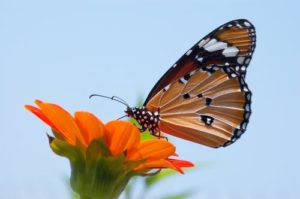
- Deadhead Crape myrtles after flower heads fade. Clipping them off encourages a second bloom. However, this may be impractical on a large shrub or tress. You can also deadhead hydrangeas and shape the bushes up a bit now, but remember that hydrangeas bloom on second-year wood, so if you prune too severely, you’ll lose next year’s flowers.
- Rejuvenate straggly plants such as geraniums, impatiens, begonias, marigolds, and blue salvia, by cutting them back now to encourage lush fall growth. Don’t forget hanging baskets.
- If shrubs have become incorrigible, cut back for appearance but do not prune.
- Divide Irises by cutting the leaves back to a height of 6″, dig out the clump, and hose away the soil. Cut the rhizomes apart with a sharp knife, leaving at least 1 fan of leaves, a few inches of healthy rhizome, and plenty of well-developed roots. Replant in shallow hole with a cone of soil in the center and the roots spread out over the cone. The top of the rhizome needs to be no deeper than 1″ below the soil surface. If you see rot on the rhizome, cut back health tissue, dust with sulfur, and place in sunshine until the wound heals before replanting. Soak the soil with a water-soluble fungicide and be sure to destroy any withered leaves.
- Divide daylilies in late August or early fall only if you must. When you replant them, be sure to give them plenty of room so you won’t need to divide them again anytime soon.
- Look for sooty mold on citrus, gardenia, crape myrtle, and other ornamentals that is caused by aphids, whiteflies, and mealy bugs. These insects may be controlled with an insecticide or insecticidal soap spray. Also, check for spider mites on ornamentals. Look for their presence on the underside of leaves. A cold blast of water from the garden hose will knock most of them off. To check for spider mites, vigorously shake a branch over a white sheet of paper and watch foe little “dots” to start moving on the paper. If you still aren’t sure, rub your hand over the specks and look for tiny streaks.
Landscape Maintenance
Fertilize roses for good fall color.
You may deadhead crape myrtles after flower heads fade. This sometimes encourages a second bloom; however it may be impractical on a large tree or shrub.
Deadhead and shape hydrangeas this month. If shrubs have become incorrigible cut back for appearance but do not prune. Remember that hydrangeas bloom on second-year wood. If you prune too severely you’ll lose next year’s flowers (Review February NOTE).
Stop fertilizing shrubs. If new shrub growth is light green, use an iron supplement to “cure” the chlorosis. Read the label carefully.
Be on the lookout for aphids, which can cause sooty mold, on crape myrtle, gardenia, citrus and other ornamentals. Aphids can be controlled by an insecticide or insecticidal soap. Look for spider mites on ornamentals on the undersides of leaves. A stiff spray of water from the garden hose will wash off a light infestation. An insecticidal soap or a light horticultural oil may be required to control mites. For heavy infestations, a miticide may be necessary. To check for spider mites, vigorously shake a branch over a white sheet of paper and watch for little “dots” to start moving on the paper. If you still aren’t sure, rub your hand over the specks and look for tiny streaks.
